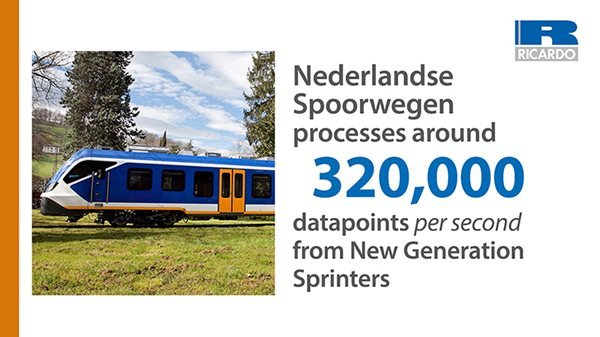How Digital Asset Monitoring can maximise value from your data
As digitalisation transforms the rail sector, so the quantity of data generated grows exponentially.

Take just one example: Dutch rail operator Nederlandse Spoorwegen currently processes around 320,000 datapoints per second from its 120-stong fleet of New Generation Sprinters.
For a sector that has long relied upon manual inspections and paper files, such vast volumes of data can feel like drinking from a fire hose.
Lacking the specialist skills or resources to isolate and extract the most critical insights from the data, operations teams can be overwhelmed by obscure diagnostics and complex measurement reports.
"Such volumes of data can feel like drinking from a fire hose."
In recent years, digital asset management has emerged to help grasp the opportunities to deliver improvements across the rail system whilst managing the challenges of data collection and analysis.
Going beyond automated alarms triggered by breached thresholds, digital asset management establishes a strategic framework for ensuring round-the-clock access to information, ensuring it is correctly filtered, prioritised and distributed to frontline teams in formats they can respond to.
By directing the right metrics to the right teams, rail organisations gain unparalleled capabilities to improve performance and reduce costs across their operations.
And by being prepared to share raw data with other parties - such as the supply chain - its value can be extended across throughout the asset lifecycle.
Pantograph monitoring, for example, is used by both operators and infrastructure managers to continuously survey the condition of pantograph units on high-traffic sections. Real-time analytics - including 3D scans and 2D images - from each location can be relayed directly to maintenance teams via bespoke dashboards that feature only the most pertinent details. Teams can then 'zoom in' on the 3D scans to inspect the damage and determine whether to request a vehicle's withdrawal for repair work.

The power of data lies in sharing and combining
But digital asset monitoring will only deliver results in organisations that have agreed their objectives and are prepared to align processes.
Consider asking some simple questions of your own organisation:
- Are you fully utilising the data already harvested from the assets and interfaces you currently monitor? Could it be reinforced with additional metrics to offer a broader real-time view of operations?
- Have you explored the market to understand current best practice? With monitoring technologies and data analytics constantly pushing at the boundaries of what can and can't be achieved, are there low-cost techniques that could offer immediate payback?
- Do you regularly engage with internal and external stakeholders to resolve governance issues, negotiate access to new data sources or agree the resources necessary to respond to what the data might have to say?
- Are you prepared to 'start small and scale up'? Digital monitoring need not apply across the entire operation from Day One. Projects focused on specific processes or asset types can become a catalyst for further investment that builds on early successes.
A digital asset monitoring strategy can be the foundation of an organisation committed to increasing efficiency and reducing costs.
With established objectives, agreed methodologies and prioritised results, the 'fire hose' of data becomes a more manageable flow of meaningful intelligence across the organisation.
We live in a world where more and more assets can manage themselves, where linking data sources can lead to new insights, and where managers can use real-time data to make decisions about operations, maintenance and innovation.
The power of data lies in sharing and combining. The technologies are already available. The challenge is knowing how to apply them within your organisation to deliver efficient solutions to complex issues.
Maarten Zanen is Team Manager Rail IT & Data at Ricardo. He is presenting a webinar entitled “How to use Digital Asset Monitoring to reduce costs and improve performance across rail operations” on April 21st 2021, 9.30am CET (8.30am BST)
www.ricardo.com

